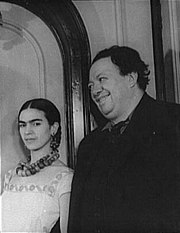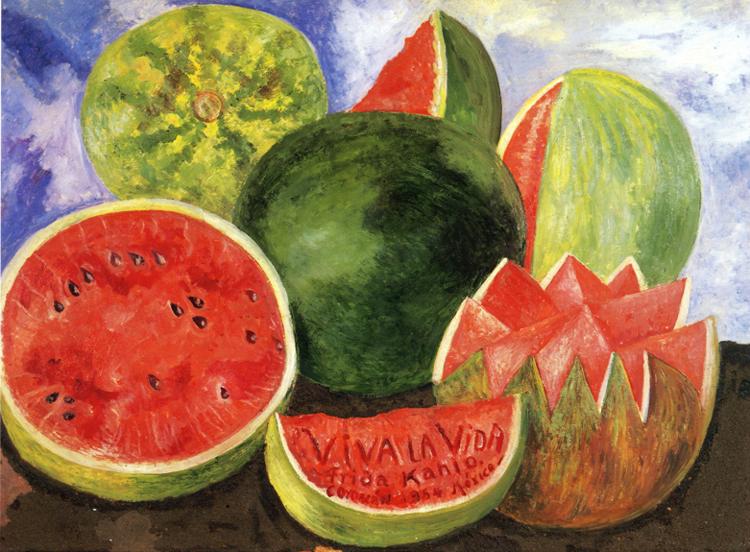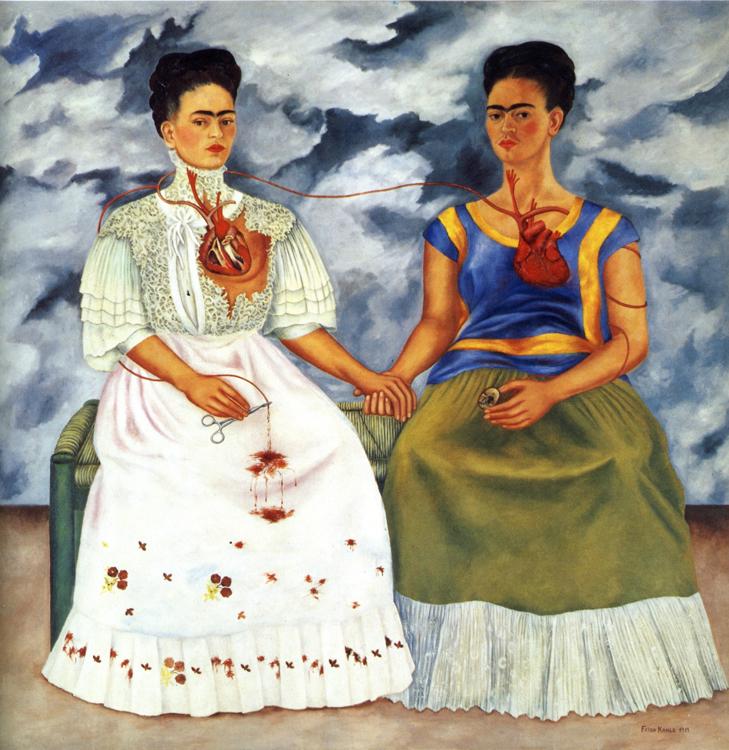Last night George and I spent a few hours learning about Frida Kahlo, a Mexican surrealist/realist painter. I do not want to judge her morality here (which was similar to the Bohemian artists and writers of the 1920's), and instead want to think about this aspect of her life,
On September 17, 1925, Kahlo was riding in a bus when the vehicle collided with a trolley car. She suffered serious injuries in the accident, including a broken spinal column, a broken collarbone, broken ribs, a broken pelvis, eleven fractures in her right leg, a crushed and dislocated right foot, and a dislocated shoulder. An iron handrail pierced her abdomen and her uterus, which seriously damaged her reproductive ability.
Although she recovered from her injuries and eventually regained her ability to walk, she was plagued by relapses of extreme pain for the remainder of her life. The pain was intense and often left her confined to a hospital or bedridden for months at a time. She underwent as many as thirty-five operations as a result of the accident, mainly on her back, her right leg and her right foot.

Frida Kahlo with Diego Rivera in 1932, by Carl Van Vechten.
After the accident, Kahlo turned her attention away from the study of medicine to begin a full-time painting career. The accident left her in a great deal of pain while she recovered in a full body cast; she painted to occupy her time during her temporary state of immobilization. Her self-portraits became a dominant part of her life when she was immobile for three months after her accident. Kahlo once said, "I paint myself because I am often alone and I am the subject I know best." Her mother had a special easel made for her so she could paint in bed, and her father lent her his box of oil paints and some brushes.[8]
Drawing on personal experiences, including her marriage, her miscarriages, and her numerous operations, Kahlo's works often are characterized by their stark portrayals of pain. Of her 143 paintings, 55 are self-portraits which often incorporate symbolic portrayals of physical and psychological wounds. She insisted, "I never painted dreams. I painted my own reality." (from Wikipedia, bold mine)
I am drawn to stories about pain, probably since my accident when I was 12 which left me immobilized in the hospital for almost a month, not to mention other heartbreaks including divorce, miscarriage and a still-birth. I find Frida's portraits refreshingly honest. She has been criticized for being self-absorbed, but I am satisfied with her reasoning given above. There is also a certain morbidity about her paintings. I can't completely say that she despaired, though there are statements that would point to that, but there are other evidences that she did not stay in that frame of mind. Her last painting of watermelons bears the caption, Viva la Vida.
The Ochlophobist's 'book club' suggestion, Orthodox Thinking on Theosis, has the title "Self-Transcendence" in the "contents". On the surface (I'm looking forward to reading what Mr. Russell says about it), I can interpret this title to promote a dialectical relationship with the idea of self, where one loses ones self. We can rest in the attitudes suggested in the Orthodox prayers, which can have a self-negating posture, but I think if we were to count the number of "I" pronouns in the Psalms, and even in many of the other prayers, penitential though they be, there would be a lot of them. We are to be honest about ourselves, not totally forgetting ourselves and our lives. Monastics tend to try to forget their past life, and make a complete break with it. They take on a completely new name, part with their possessions and heirlooms, and do not wish to be asked about their past before the monastery, after a certain period anyway. Probably the later vows. Frida painted a dialectical relationship with her self, not of negation by any means, but one that showed how her husband Diego saw her, the Frida he liked, and the Frida he didn't.
This was her perception of how he saw her anyway. I suppose that is what Frida did best, she painted her perceptions from her point of view. I don't want to invalidate this. She struggled to not be consumed by her pain. She struggled very long and intensely. She neither denied it, nor let it completely blind her to the beauty in the world, though she was blinded to beauty immediately after her accident. She said at that time that there was nothing beyond the ugliness of the world, and if there was she would be able to see it. She didn't stay there though. Maybe that's why she was spared, she learned to see the beauty again, even in herself. Her self-portraits can be pretty harsh, but there is a certain acknowledgment of the divine spark, a certain retained comeliness of form.
One painting in particular describes external, imposed pain pretty well, as do the ones of her miscarriages. [I've removed it here, but if you click on one of the other paintings it will take you to her gallery, which can be graphic]
I can't help but be reminded of the cross and the cup of suffering that our Lord accepted. Frida was not ignorant of Christ's sufferings, even though she rejected the Catholicism of her upbringing. Her exposure to Mexican religious art also influenced her paintings.
Perhaps though, when one has suffered, it is easy to get caught up in a persecution/Messiah complex. On one hand this can draw one to Christ, who also suffered, but it is probably easy to slip into the delusion that one is innocent, sinless, and undeserving, or worse, Divine, as He. I sort of like people with Messiah complexes though because they can try harder to act like Christ, with whom they identify. Frida built a garden of Eden out of the home of her childhood, and gave art classes there, Bohemian though they were. But we are not sinless. We can't be naked in the garden. Should she have been so naked in her sufferings as well? One thing being in the hospital does, is that it strips you naked. Indeed even during the bus collision, all of her clothes were torn away and she lay naked and impaled on the ground. During surgery one is stripped bare, and in recovery, there are those stupid gowns, barely on, which the staff draws back with too-familiar ease and entitlement. Necessary evil?
How can one pretend modesty after that? Once one has been involuntarily exposed to the world, what's the use of covering up? If I had had complete control of who to trust to expose myself to, the list would have included two people only. As an infant, a trusted child care provider, who loved me, and then no one until the husband of my choice who would also deliver my baby. To keep that list so short, should I risk my and my babies' lives? I'm going to leave the door open on that one. If they had been the only two, I probably wouldn't be blogging. But since there have been many breaches of protection of my privacy, I want to take control of the information I suppose. That's what Farah Fawcett did when she was diagnosed with cancer. Since the National Enquirer told it wrong, she decided to tell it and produced her own documentary chronicling the last few years of her life and her struggle. I'm glad for her and Frida's sharing of their pain. Frida said that she felt we are all united. When one expresses ones self openly, one is voluntarily inviting a certain type of communion. Oh yes, it was related in the PBS documentary that Frida became communist because of a mistaken idea that it would bring about community, where she wouldn't be alone in her suffering. I'm going to cut her and Farah some slack and pray for mercy on their souls.


No comments:
Post a Comment